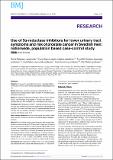| dc.contributor.author | Robinson, David | en_US |
| dc.contributor.author | Garmo, Hans | en_US |
| dc.contributor.author | Bill-Axelson, Anna | en_US |
| dc.contributor.author | Mucci, Lorelei | en_US |
| dc.contributor.author | Holmberg, Lars | en_US |
| dc.contributor.author | Stattin, Pär | en_US |
| dc.date.accessioned | 2014-02-13T19:01:04Z | |
| dc.date.issued | 2013 | en_US |
| dc.identifier.citation | Robinson, David, Hans Garmo, Anna Bill-Axelson, Lorelei Mucci, Lars Holmberg, and Pär Stattin. 2013. “Use of 5α-reductase inhibitors for lower urinary tract symptoms and risk of prostate cancer in Swedish men: nationwide, population based case-control study.” BMJ : British Medical Journal 346 (1): f3406. doi:10.1136/bmj.f3406. http://dx.doi.org/10.1136/bmj.f3406. | en |
| dc.identifier.issn | 0959-8138 | en |
| dc.identifier.uri | http://nrs.harvard.edu/urn-3:HUL.InstRepos:11708557 | |
| dc.description.abstract | Objective: To assess the association between 5α-reductase inhibitor (5-ARI) use in men with lower urinary tract symptoms and prostate cancer risk. Design: Nationwide, population based case-control study for men diagnosed with prostate cancer in 2007-09 within the Prostate Cancer data Base Sweden 2.0. Setting: The National Prostate Cancer Register, National Patient Register, census, and Prescribed Drug Register in Sweden, from which we obtained data on 5-ARI use before date of prostate cancer diagnosis. Participants: 26 735 cases and 133 671 matched controls; five controls per case were randomly selected from matched men in the background population. 7815 men (1499 cases and 6316 controls) had been exposed to 5-ARI. 412 men had been exposed to 5-ARI before the diagnosis of a cancer with Gleason score 8-10. Main outcome measures Risk of prostate cancer calculated as odds ratios and 95% confidence intervals by conditional logistic regression analyses. Results: Risk of prostate cancer overall decreased with an increasing duration of exposure; men on 5-ARI treatment for more than three years had an odds ratio of 0.72 (95% confidence interval 0.59 to 0.89; P<0.001 for trend). The same pattern was seen for cancers with Gleason scores 2-6 and score 7 (both P<0.001 for trend). By contrast, the risk of tumours with Gleason scores 8-10 did not decrease with increasing exposure time to 5-ARI (for 0-1 year of exposure, odds ratio 0.96 (95% confidence interval 0.83 to 1.11); for 1-2 years, 1.07 (0.88 to 1.31); for 2-3 years, 0.96 (0.72 to 1.27); for >3 years, 1.23 (0.90 to 1.68); P=0.46 for trend). Conclusions: Men treated with 5-ARI for lower urinary tract symptoms had a decreased risk of cancer with Gleason scores 2-7, and showed no evidence of an increased risk of cancer with Gleason scores 8-10 after up to four years’ treatment. | en |
| dc.language.iso | en_US | en |
| dc.publisher | BMJ Publishing Group Ltd. | en |
| dc.relation.isversionof | doi:10.1136/bmj.f3406 | en |
| dc.relation.hasversion | http://www.ncbi.nlm.nih.gov/pmc/articles/PMC3685512/pdf/ | en |
| dash.license | LAA | en_US |
| dc.title | Use of 5α-reductase inhibitors for lower urinary tract symptoms and risk of prostate cancer in Swedish men: nationwide, population based case-control study | en |
| dc.type | Journal Article | en_US |
| dc.description.version | Version of Record | en |
| dc.relation.journal | BMJ : British Medical Journal | en |
| dash.depositing.author | Mucci, Lorelei | en_US |
| dc.date.available | 2014-02-13T19:01:04Z | |
| dc.identifier.doi | 10.1136/bmj.f3406 | * |
| dash.contributor.affiliated | Mucci, Lorelei | |


